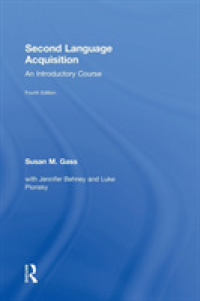- ホーム
- > 洋書
- > ドイツ書
- > Humanities, Arts & Music
- > Linguistics
- > general surveys & lexicons
Full Description
Collaboratively Constructed Language Resources (CCLRs) such as Wikipedia, Wiktionary, Linked Open Data, and various resources developed using crowdsourcing techniques such as Games with a Purpose and Mechanical Turk have substantially contributed to the research in natural language processing (NLP). Various NLP tasks utilize such resources to substitute for or supplement conventional lexical semantic resources and linguistically annotated corpora. These resources also provide an extensive body of texts from which valuable knowledge is mined. There are an increasing number of community efforts to link and maintain multiple linguistic resources.
This book aims offers comprehensive coverage of CCLR-related topics, including their construction, utilization in NLP tasks, and interlinkage and management. Various Bachelor/Master/Ph.D. programs in natural language processing, computational linguistics, and knowledge discovery can use this book both as the main text and as a supplementary reading. The book also provides a valuable reference guide for researchers and professionals for the above topics.
Contents
Part I Approaches to Collaboratively Constructed Language Resources.- 1.Using Games to Create Language Resources: Successes and Limitations of the Approach. J.Chamberlain, K.Fort, U.Kruschwitz, M.Lafourcade and M.Poesio.- 2.Senso Comune: A Collaborative Knowledge Resource for Italian. Al.Oltramari, G.Vetere, I.Chiari, E.Jezek, F.M.Zanzotto, M.Nissim, and A.Gangemi.- 3.Building Multilingual Language Resources in Web Localisation: A Crowdsourcing Approach. A.Wasala, R.Schäler, J.Buckley, R.Weerasinghe and C.Exton. - 4.Reciprocal Enrichment Between Basque Wikipedia and Machine Translation.- I.Alegria, U.Cabezon, U.Fernandez de Betoño, G.Labaka, A.Mayor, K.Sarasola and A.Zubiaga.- Part II Mining Knowledge From and Using Collaboratively Constructed Language Resources.- 5.A Survey of NLP Methods and Resources for Analyzing the Collaborative Writing Process in Wikipedia. O.Ferschke, J.Daxenberger and I.Gurevych.- 6.ConceptNet 5: A Large Semantic Network for Relational Knowledge. R.Speer and C.Havasi.- 7.An Overview of BabelNet and its API for Multilingual Language Processing. R.Navigli and S.P.Ponzetto.- 8.Hierarchical Organization of Collaboratively Constructed Content. J.Yu, Z-J.Zha, and T-S.Chua.- 9.Word Sense Disambiguation using Wikipedia. B.Dandala, R.Mihalcea, and R.Bunescu.- Part III Interconnecting and Managing Collaboratively Constructed Language Resources.- 10.An Open Linguistic Infrastructure for Annotated Corpora. N.Ide.- 11.TowardsWeb-Scale Collaborative Knowledge Extraction. S.Hellmann, S. Auer.- 12.Building a Linked Open Data Cloud of Linguistic Resources: Motivations and Developments. C.Chiarcos, S.Moran, P.N.Mendes, S.Nordhoff, R.Littauer.- 13.Community Efforts around the ISOcat Data Category Registry. S.E.Wright, M.Windhouwer, I.Schuurman, M.Kemps-Snijders.- Index.







